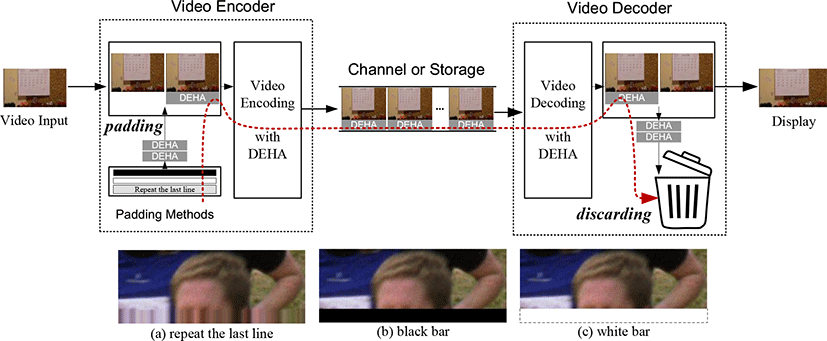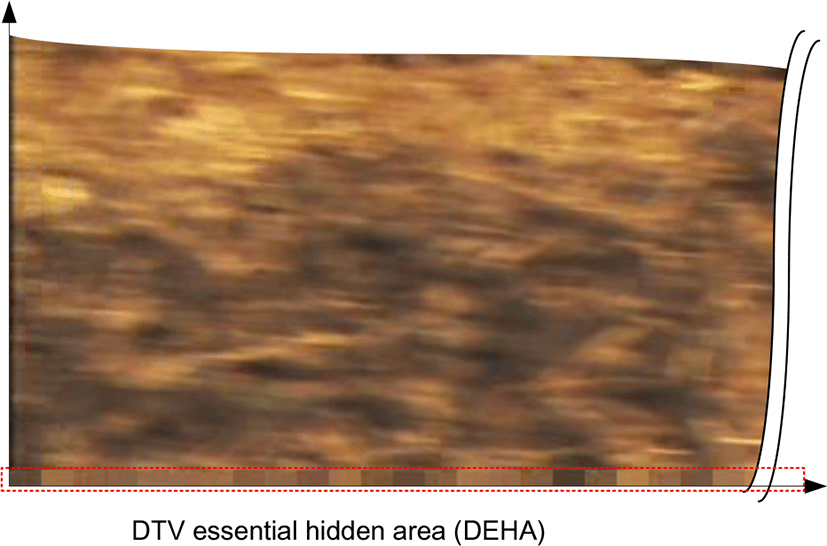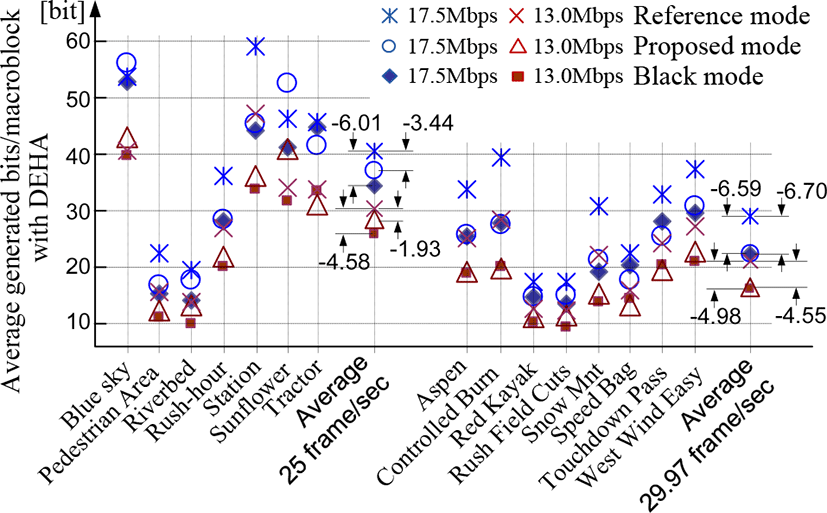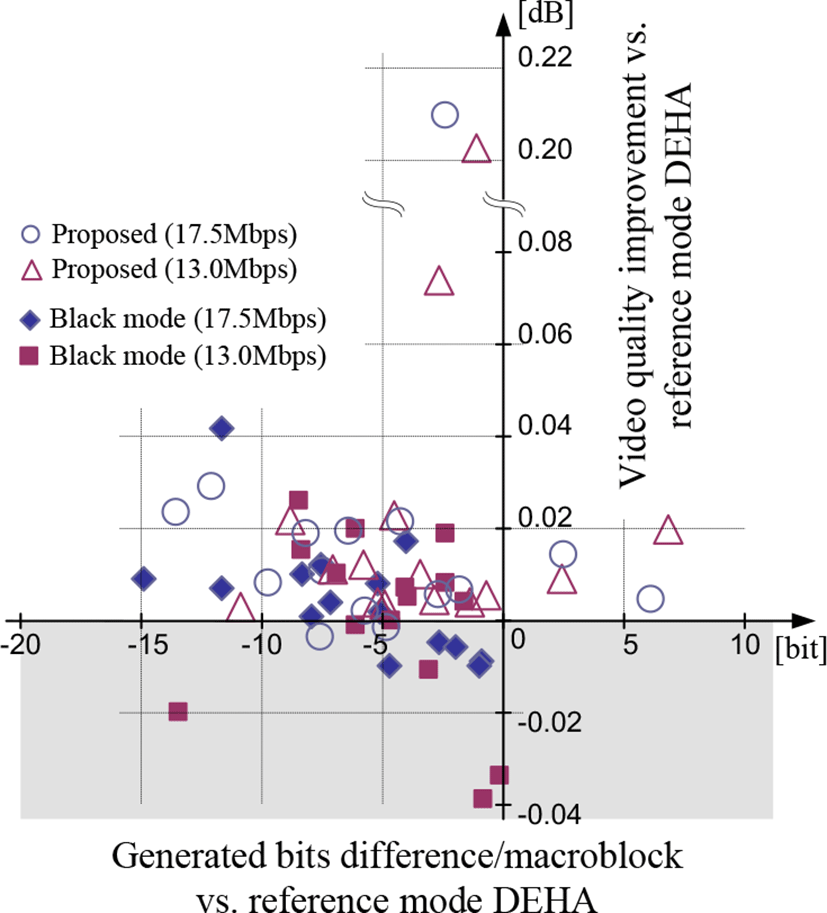I. INTRODUCTION
The storage or transmission of digital video content for DTV, including ultra-high definition (UHD) video, as represented in a data file or bitstream, is processed according to a video compression format. The standard format for DTV video coding is MPEG-2/4/H [1-3]. Based on this standard for Full HD and UHD broadcasting, an additional 8, 16, or 32 vertical lines must be added to every video frame, which comprises the DTV essential hidden area (DEHA) and is essential for the effective functioning of the MPEG-2/4/H encoder, stream, and decoder.
The DEHA is formed by padding the last line signal of input video at the bottom of the active video in an MPEG-2/4/H reference encoder. Once the DEHA is padded in the video encoder, it is then compressed with the active video, transferred to the decoder as part of the video stream, and then decoded in the video decoder. After decoding, the DEHA is discarded by the video decoder. However, while the DEHA is essential in the video encoding/decoding process, the DEHA is redundant in the channel utilization or storage efficiency. Hence, a purpose of this paper is to propose a method it effectively utilize the DEHA as a means of improving the video quality of digital broadcasting, which has not been researched to date.
This paper proposes a block mode DEHA method to more effectively utilize the DEHA as compared to conventional DEHA utilization. The block mode DEHA method is based on reducing the amount of DEHA data in the compressed video stream, which can improve the quality of the active video, by partitioning the DEHA as macroblocks. In theory, the proposed block mode DEHA method eliminates all DEHA data in the video stream, which suggests a significant improvement in both channel utilization and storage efficiency, and an overall improvement in video quality. Moreover, the proposed method can be easily implemented with existing video encoders, requiring only marginal and simple changes, which adds to the method’s attractiveness.
II. CONVENTIONAL DEHA
In DTV broadcasting systems, the vertical size of a picture in video stream specifies the height of each encoded picture, which is the height of the displayable part of the luminance component of the frame lines. In order to avoid start code emulation, the vertical size value should not be equal to 0 and should be an integer multiple of a basic encoding element such as a macroblock or coding tree unit of MPEG-2/4/H (i.e., 16, 32 or 64 lines).
The standardization of DTV during the past several years has proven to be a challenging process, resulting in a multitude of standards and resolutions such as 1920×1080, 3840×2160, and 7680×4320. Indeed, video encoders add an extra 16 vertical lines to the 3840×2160 resolution, which results in a frame size of 3840×2176. As shown in Table 1 and Figure 1, the extra 8, 16, or 32 lines comprise the DEHA, which is essential to the effectiveness of the encoder, stream, and decoder, and is created by padding the bottom of the active video source.
| Location | Pixel Size (H×V) | ||
|---|---|---|---|
| Full HD | 4K UHD | 8K UHD | |
| Active video input/output | 1920×1080 | 3840×2160 | 7680×4320 |
| DEHA | 1920×8 | 3840×16 | 7680×32 |
| CODEC and stream | 1920×1088 | 3840×2176 | 7680×4352 |
As depicted in Figure 1(a), the current and conventional use of DEHA pads the last line signal of the input video at the bottom of the active video in MPEG-2/4/H reference encoders, helped by improved IC data processing speeds. This compares to early real-time H/W encoders that padded the DEHA with white, gray, or black bars, as shown in Figure 1(b-c). While the choice of DEHA mode has revealed minute differences in video quality, the differences are considered negligible and can be ignored. MPEG-2/4/H reference software suggests the use of the last line signal of the input video for reference mode DEHA.
The DEHA is essential for the video encoding and decoding process to function effectively: a process that commences with the DEHA padded in the video encoder, which is then compressed with the active video, transferred to the decoder as part of the video stream, and decoded in the video decoder. Once decoded, the DEHA is discarded. However, despite its essential function, the DEHA is currently viewed as being redundant in terms of channel utilization and storage efficiency. Hence, a core purpose of this research is to examine and propose methodology to more effectively utilize the DEHA, which has not been researched to date. Notably, this paper proposes a block mode DEHA method to replace the conventional use of DEHA, an improved method that reduces the amount of DEHA data in the compressed video stream, and consequently, improves the quality of the active video.
III. BLOCK MODE DEHA
Real-time H/W encoders have conventionally padded the DEHA with the last line signal of the input data or with black bars. The underlying unit to utilize the DEHA is a combination of representative block images. For example, in the case of video in DTV broadcasting, the DEHA is comprised of 240 block images. While the data comprising the DEHA serves no essential purpose, the quality of the active video can be compromised in the compression process as the quantity of the DEHA data increases; hence, the amount of compressed data in the DEHA should be minimized to preserve the quality of the active video.
Figure 2 depicts the encoding process of the 2nd macro-block within the DEHA. Notably, the numbers in the subscript of each image represent the location of the coefficient. For example, n0 represents the DC coefficient of the n-th block average while nx and ny represents the horizontal and vertical coefficient of the block image in the transformed domain. Moreover, the 1st and 2nd blocks in each image represent macroblocks in the active video region while the 3rd and 4th blocks represent macroblocks in the DEHA. Finally, the text description underneath each image represents the DEHA data that must be compressed for each example.
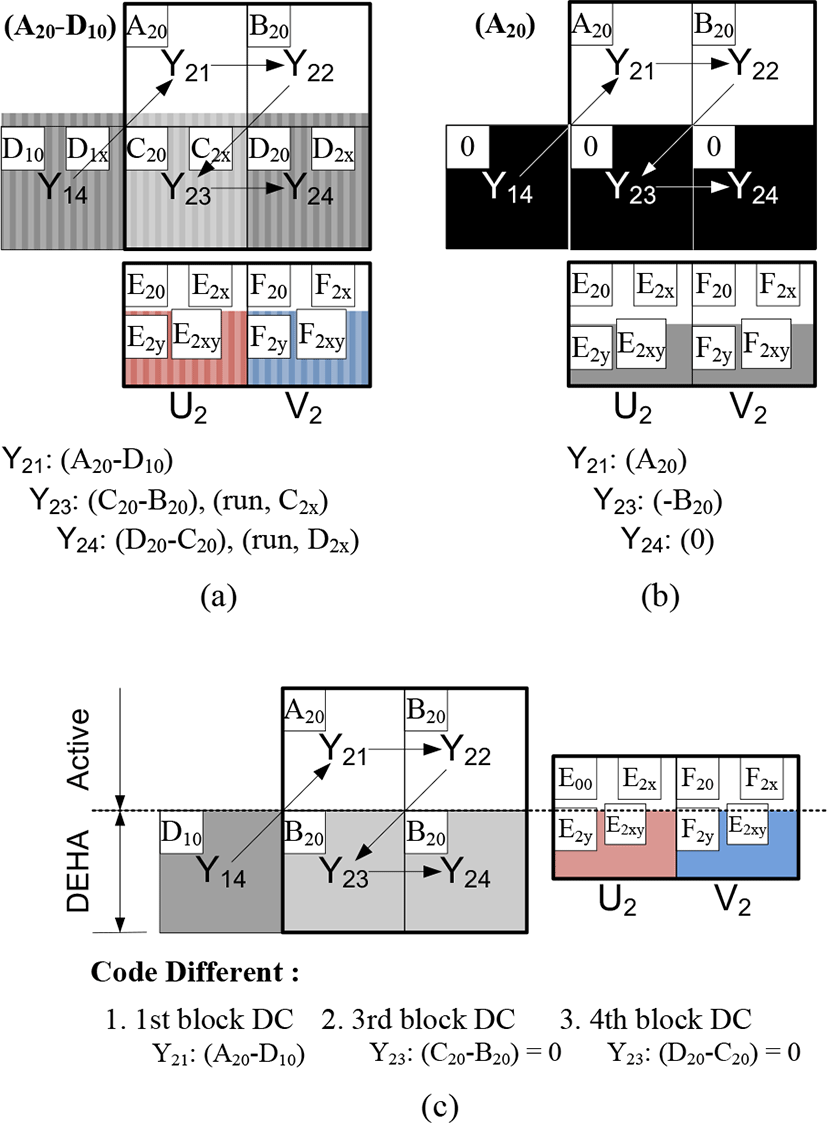
As shown in Figure 2(a), the reference mode DEHA method of compression generates significant DEHA data through repeating the last line signal of the input video. In contrast and at first glance, the black mode DEHA method appears to generate little or no data. However, the black mode DEHA method actually generates 120 pieces of DC data in each video frame in the 3rd block. Additionally, the first coded data of the 1st block in each macroblock have larger values than that of the reference mode. For example, A20 in Figure 2(b) is greater than (A20-D10) in Figure 2(a). In summary, both conventional methods result in additional DEHA data that must be compressed and potentially compromise the quality of the active video stream.
To minimize the size of DEHA data in the compressed video stream, this paper proposes the use of block mode DEHA. This is accomplished by evenly filling the values of the 3rd and 4th DEHA blocks with the DC coefficient of the 2nd block for every macroblock as shown in Figure 3. The use of block images is advantageous, given that only the DC value remains after transforming the DCT or wavelet; hence, the compression efficiency increases.
As shown in Figure 2(c), the block mode DEHA method suggests that the 3rd and 4th blocks contain no data for encoding, given that the DC values in the 3rd and 4th blocks are the same as the DC value transformed from the 2nd block. Hence, in theory, the proposed block mode DEHA method eliminates all DEHA data in the video stream, which suggests a significant improvement in both channel utilization and storage efficiency, and an overall improvement in video quality.
IV. EXPERIMENTAL RESULTS
Seven test sequences based on the Taurus Media Technik and eight real sequences based on the NTIA/ITS for video quality research were used to evaluate the proposed method [4-5]. The resolution of each sequence was progressive at a resolution of 1920×1080 and frame rates of 25frames/sec and 29.97frames/sec, respectively. Tables 2 and 3 summarize the characteristics of each sequence for video coding.
Test sequences were all compressed with constant bit rate (CBR) coding using MPEG reference software of MPEG software simulation group.
The bitrates for MPEG CBR were set at 13Mbps and 17.5Mbps, based on the lower and upper bounds of TTA for HDTV broadcasting in Korea [5]. To analyze the DEHA, the GOP structure was fixed and set to closed-GOP for random access. As shown in Figure 4, the block mode DEHA padded at the bottom of the image was then compressed.
To analyze the effects of the proposed DEHA method based on block mode DEHA, an experiment was conducted using MPEG CBR compression to compare the generated bits per frame from the proposed method against the conventional, reference method. The test results confirmed that the effects of the block mode DEHA method on the rate control were minimal as compared to the reference method, as shown in Table 4 and Fig 5.
Table 4 shows that the average generated bits of macroblock with DEHA vary according to the video stream rate of each sequence. According to the theoretical expectations of the proposed method, the average generated bit results were smaller than conventional methods in four sequences; namely, Tractor, Controlled Burn, Speed Bag, and Touchdown Pass. In general, the black mode generated the smallest amount of bits per sequence while the proposed method generating bit results more closely aligned with the black mode than the reference mode.
Contrary to theoretical expectations, the proposed method generated bit results greater than conventional methods in two sequences, Blue Sky and Sunflower. To examine these results more closely, a detailed analysis of the average generated bits of the Blue Sky sequence at 13.0Mbps in picture type is shown in Fig 6.
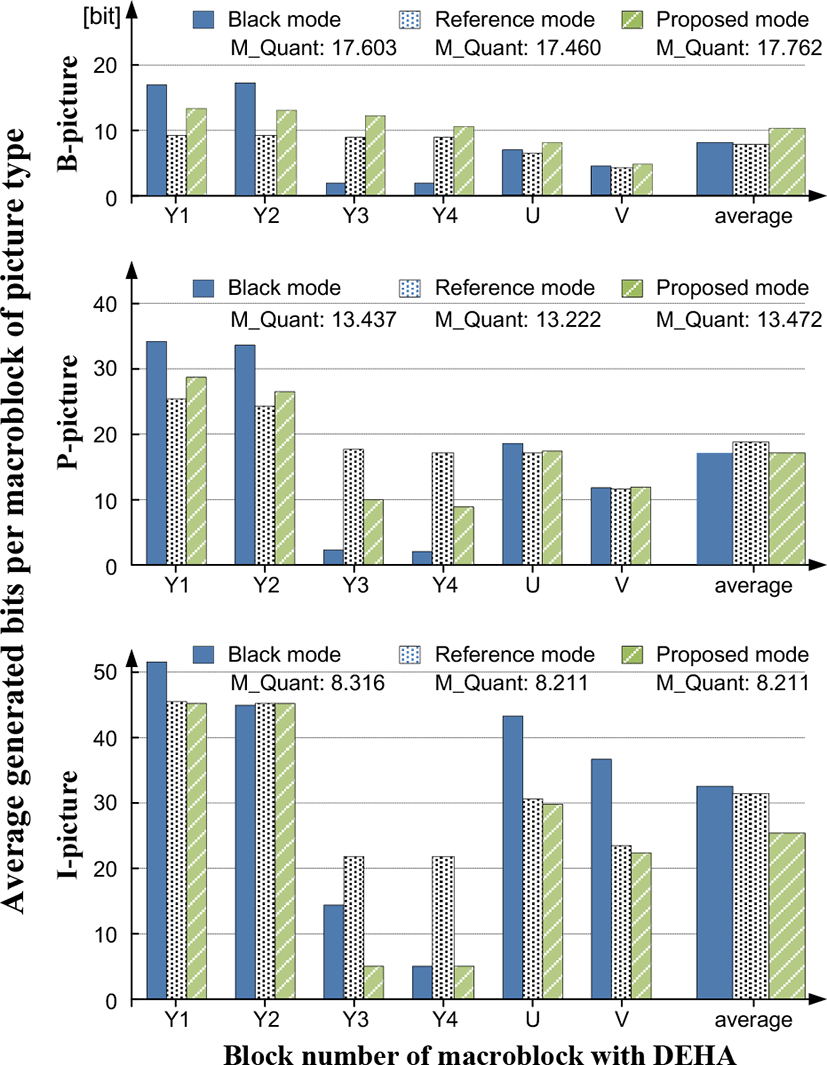
In support of the theoretical expectations of the proposed method, the I-picture at the bottom of Figure 6 shows the average generated bits precisely, which show the proposed method generated the smallest bit values. As described in Figure 2(b), the generated bits of the 1st and 3rd blocks of the black mode increased, while the generated bits of 3rd and 4th blocks are smaller values than that of the reference mode, as depicted in the P-picture. However, as shown in the B-picture, the values of all blocks of the proposed method are greater than that of the reference mode, due to horizontal motion in the video sequence as referenced by the horizontal coefficients Cnx and Dnx.
In summary, the experimental results validated the effectiveness of the proposed block mode DEHA in reducing the bitrate of DEHA in compressed video streams. As shown in the I-picture, the proposed method generates the smallest bits as compared to conventional methods. Moreover, due to the effects of motion estimation and compensation, the proposed method generates bits quite smaller than the reference mode and slightly larger than the black mode for B- and P-pictures, respectively. Experimental testing of the proposed block mode DEHA method revealed that the method reduced the number of bits by an average of -3.44 bits per macroblock for diverse test sequences (25frames/sec) and by -6.70bits per macroblock for real sequences (29.97frames/sec), as compared to the conventional reference DEHA method.
A second experiment was conducted to analyze the quality of the active region and DEHA upon reconstruction of the compressed video stream that included block mode DEHA. Results revealed an overall quality improvement of the active region, as shown in Table 5, Figure 7, and Figure 8.
As shown in Table 5, test sequences were compressed at a quality level ranging between 33dB and 44dB based on the proposed block mode DEHA at a frame rate of 25frames/sec. Compression qualities of almost sequences improved on average by 0.025dB. Moreover, the compression quality of all sequences was above 35dB, evidence of good quality, while the average compression quality of all sequences at a frame rate of 29.97frames/sec improved by 0.037dB at 17.5Mbps.
To summarize, as shown in this experiment of diverse test sequences, the video quality of DTV broadcasting can be improved in excess of 0.010dB through effective utilization of the DEHA, based on the block mode DEHA method. Moreover, a key advantage of the proposed block mode DEHA is its simplicity and implementation ease, as compared to the time, resources, and effort required to develop new video encoding theory or algorithms. For example, consider the current dilemma facing developers to secure computing power as a means of improving video quality by 0.037dB. In contrast, such quality improvements can be easily secured through minor changes to a conventional video encoder utilizing the proposed block mode DEHA method. And such improvements can raise the quality by at least 0.010dB.
III. CONCLUSION
The compression of video in both Full HD and UHD broadcast systems requires the inclusion of DEHA for the effective functioning of encoder, stream, and decoder. The DEHA is formed by padding extra vertical lines at the bottom of the active video, which is then compressed with active video, transferred to the decoder as part of the video stream, and then decoded in the video decoder. After decoding, the DEHA is discarded by the video decoder.
However, while the encoding/decoding process is dependent on the DEHA, the DEHA is conventionally viewed as a redundancy in terms of channel utilization and storage efficiency. However, as shown through experiments in this paper, the DEHA can be utilized as an essential feature in the encoding/decoding process of active video that can improve the quality of video broadcasting, which has not been researched or utilized to date.
This paper has proposed a block mode DEHA method to more effectively utilize the DEHA, based on the underlying assumption that the quality of active video can be improved by reducing the amount of DEHA data in the compressed video stream through improved channel utilization and storage efficiency. The proposed block mode DEHA achieves this assumption by partitioning video block images, including the DEHA, into macroblocks, of which the representative DEHA macroblocks are then evenly filled with the average DC coefficient of the active video macroblock. Theoretically, this process results in no DEHA data entering the video stream.
Experimental testing of the proposed block mode DEHA method revealed that the method reduced the number of bits by an average of -3.44bits per macroblock for diverse test sequences (25 frames/sec) and by -6.70bits per macroblock for real sequences (29.97 frames/sec), as compared to the conventional reference DEHA method. Moreover, experimental testing also found that the proposed block mode DEHA method improved the video quality on average by 0.018dB in test sequences (25 frames/sec) and by 0.037dB in real sequences (29.97 frames/sec).
The proposed block mode DEHA method provides evidence of not only improving video quality through more effective channel utilization and storage efficiency, but the method is also extremely easy to implement into conventional video encoders through minor and simple changes as compared to the time, resources, and effort required developing new video encoding or algorithms.
